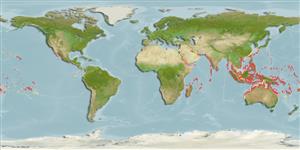Common names from other countries
Environment: milieu / climate zone / depth range / distribution range
Sinh thái học
Cùng sống ở rạn san hô; Mức độ sâu 0 - 50 m (Ref. 800). Tropical; 31°N - 25°S, 31°E - 134°W
Indo-Pacific excluding Hawaii.
Length at first maturity / Bộ gần gũi / Khối lượng (Trọng lượng) / Age
Maturity: Lm ?, range 30 - ? cm Max length : 80.0 cm TL con đực/không giới tính; (Ref. 122); common length : 45.0 cm TL con đực/không giới tính; (Ref. 122); Khối lượng cực đại được công bố: 7.0 kg (Ref. 122)
Mean live weight: 2500-7000 g. Body-wall thickness: 0.15 cm. Body firm, rigid, flattened ventrally (trivium). Bivium entirely covered with characteristic, large, leaf-shaped, lobate papillae. Trivium with brown to pink podia, more numerous on the radii, their disc about 0.04 cm in diameter, Mouth ventral, surrounded by a circle of conical papillae which are larger on dorsal side, and 20 large, brown tentacles. Anus terminal. Calcareous ring with large radial pieces and narrow interradials. Cuvierian tubules absent. Color variable on bivium, reddish orange to brown; trivium generally red; mature gonads deep purple. Spicules on tegument with cross-shaped spicules, spiny branched spicules (sometimes with median pillar), perforated plates, pseudo-tables, and grains; branched spicules larger in dorsal tegument and papillae; ventral podia with branched spicules, long rods, and large, multiperforated plates; tentacles with characteristic branched spicules, in form of a "rose-window".
Populations not reaching very high densities, with a mean of around 0.003 per square meter. Harvested by hand. Collected by skin diving or using diving gear (if not banned), making the populations very vulnerable, due to overexploitation. The processed product is of major quality and the demand is still high (Ref. 122). Maximum depth from Ref. 122154. A common reef species mostly found from near the surface to a depth of 25 m; generally occurs on hard bottoms, large rubble and coral patches, on reef slopes and near passes. Symbiotic pearlfish (Carapidae, Ophidiiformes) are often found in its general cavity (Ref. 122); common on exposed sandy bottoms or rubble areas of the reef fringe from 10 to 30 m (Ref. 800). Also found on seagrass (Ref. 122153). Associated with commensal pearlfish that live in the body cavity (Ref. 800). This is also found in lagoons at depths up to 30 m on clean sandy bottoms or on slabs near large coral heads. It feeds exclusively on calcareous alga Halimeda sp. (Ref. 118).
Sexual reproduction takes places during warm season. A species with a low potential fecundity and late sexual maturity.
Conand, C. 1998. (Ref. 122)
IUCN Red List Status (Ref. 130435)
CITES status (Ref. 108899)
Not Evaluated
Threat to humans
Harmless
Human uses
Các nghề cá: tính thương mại cao
FAO - Các nghề cá: landings | FishSource |
Các công cụ
Các nguồn internet
Estimates based on models
Preferred temperature
(Ref.
115969): 25 - 29.3, mean 28.4 (based on 3386 cells).
Vulnerability
Moderate to high vulnerability (52 of 100).
Price category
Unknown.
